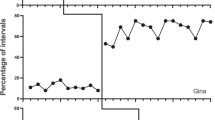Abstract
Slocum et al. (this issue) provide well-reasoned arguments for the use of nonconcurrent multiple baseline designs in behavior analytic work, despite historical preference for concurrent designs (i.e., simultaneous baseline initiation) and contemporary guidelines in related fields suggesting that nonconcurrent designs are insufficient for evaluating functional relations (What Works Clearinghouse, 2020). I provide a commentary, highlighting major contributions of this article and suggesting areas of further consideration. In sum, I agree with authors that researchers should avoid wholesale dismissal of nonconcurrent designs. I also agree that understanding how multiple-baseline designs control for and allow for detection of threats to internal validity is critical so that authors can apply the variation of the design that allows them to draw confident conclusions about relations between independent and dependent variables.
Similar content being viewed by others
References
Carr, J. E. (2005). Recommendations for reporting multiple-baseline designs across participants. Behavioral Interventions: Theory & Practice in Residential & Community-Based Clinical Programs, 20(3), 219–224. https://doi.org/10.1002/bin.191
Christ, T. J. (2007). Experimental control and threats to internal validity of concurrent and nonconcurrent multiple baseline designs. Psychology in the Schools, 44(5), 451–459. https://doi.org/10.1002/pits.20237
Coon, J. C., & Rapp, J. T. (2018). Application of multiple baseline designs in behavior analytic research: Evidence for the influence of new guidelines. Behavioral Interventions, 33(2), 160–172. https://doi.org/10.1002/bin.1510
Hammond, D., & Gast, D. L. (2010). Descriptive analysis of single subject research designs. Education and Training in Autism & Developmental Disabilities, 187–202.
Harvey, M. T., May, M. E., & Kennedy, C. (2004). Nonconcurrent multiple baseline designs and the evaluation of educational systems. Journal of Behavioral Education, 13(4), 267–276. https://doi.org/10.1023/B:JOBE.0000044735.51022.5d
Hayes, S. C. (1981). Single case experimental design and empirical clinical practice. Journal of Consulting & Clinical Psychology, 49(2), 193–211 10.1037/0022-006X.49.2.193.
Hersen, M., & Barlow, D. H. (1976). Single case experimental designs. Pergamon.
Kratochwill, T. R., Horner, R. H., Levin, J. R., Machalicek, W., Ferron, J., & Johnson, A. (2021). Single case design standards: An update and proposed upgrades. Journal of School Psychology, 89, 91–105. https://doi.org/10.1016/j.jsp.2021.10.006
Ledford, J. R., & Gast, D. L. (Eds.). (2018). Single subject research methodology in behavioral sciences: Applications in special education and behavioral sciences. Routledge.
Ledford, J. R., & Zimmerman, K. N. (2022). Rethinking rigor in multiple baseline designs across participants. https://osf.io/e98nw/
Ledford, J. R., Barton, E. E., Severini, K. E., Zimmerman, K. N., & Pokorski, E. A. (2019). Visual display of graphic data in single case design studies: Systematic review and expert preference analysis. Education & Training in Autism & Developmental Disabilities, 54(4), 315–327 https://www.jstor.org/stable/26822511
Ledford, J. R., Lambert, J. M., Pustejovsky, J. E., Zimmerman, K. N., Hollins, N. A., & Barton, E. E. (2022). Single case design research in special education: Next generation standards and considerations. https://osf.io/bt9hf/
Pustejovsky, J. E., Swan, D. M., & English, K. W. (2021). An examination of measurement procedures and characteristics of baseline outcome data in single-case research. Behavior Modification. Advance online publication. https://doi.org/10.1177/0145445519864264
Shadish, W. R., & Sullivan, K. J. (2011). Characteristics of single-case designs used to assess intervention effects in 2008. Behavior Research Methods, 43(4), 971–980. https://doi.org/10.3758/s13428-011-0111-y
Watson, P. J., & Workman, E. A. (1981). The non-concurrent multiple baseline across-individuals design: An extension of the traditional multiple baseline design. Journal of Behavior Therapy & Experimental Psychiatry, 12(3), 257–259. https://doi.org/10.1016/0005-7916(81)90055-0
What Works Clearinghouse. (2020). Standards handbook (v. 4.1). https://ies.ed.gov/ncee/wwc/handbooks
Author information
Authors and Affiliations
Corresponding author
Ethics declarations
Conflict of Interest
Jennifer R. Ledford is the editor of a single-case design textbook which is cited in this commentary, and for which she receives royalties.
Additional information
Publisher’s Note
Springer Nature remains neutral with regard to jurisdictional claims in published maps and institutional affiliations.
Rights and permissions
About this article
Cite this article
Ledford, J.R. Concurrence on Nonconcurrence in Multiple-Baseline Designs: A Commentary on Slocum et al. (2022). Perspect Behav Sci 45, 661–666 (2022). https://doi.org/10.1007/s40614-022-00342-1
Accepted:
Published:
Issue Date:
DOI: https://doi.org/10.1007/s40614-022-00342-1




